#alexandra feodorovna
Text

Laurits Tuxen (1853-1927, Danish) ~ The Marriage of Nicholas II and Alexandra Feodorovna, Empress of Russia, 26th November 1894, c. 1895-96
[Source: rct.uk]
553 notes
·
View notes
Text

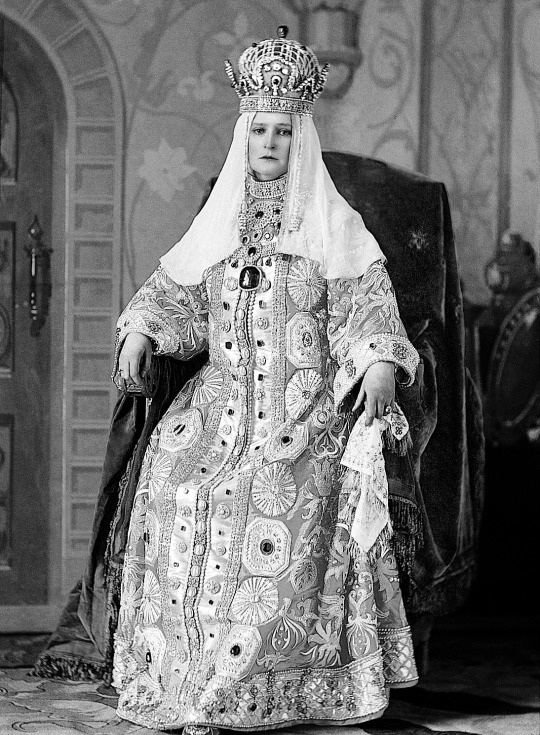
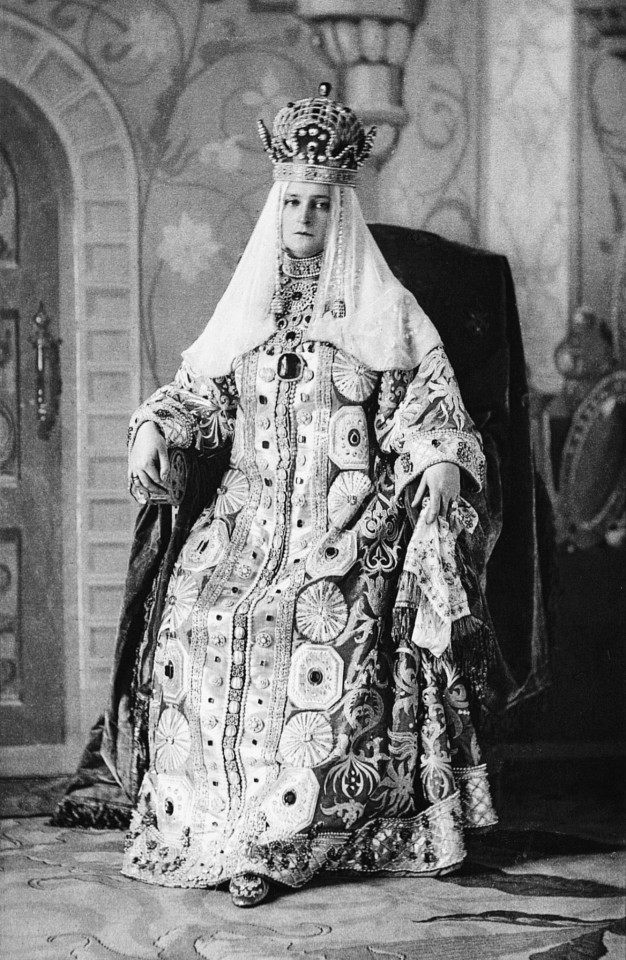

Portraits of Empress Alexandra Feodorovna of Russia along with Emperor Nicholas II of Russia, wearing costumes of Tsar Alexei and Tsarina Maria Ilyinichna Miloslavskaya for the 300 years anniversary of the Romanov dynasty, Winter Palace, 1903.
#alix of hesse#alix of hesse and by rhine#alexandra feodorovna#louis iv#princess alice#princess alice of the united kingdom#queen victoria#prince albert#albert#victoria#victorian#victorian era#germany#hesse#rhine#russia#princess#empress#tsarina#czarina#tsaritsa#royal#royalty#history#portrait#photo#nicholas ii
156 notes
·
View notes
Text
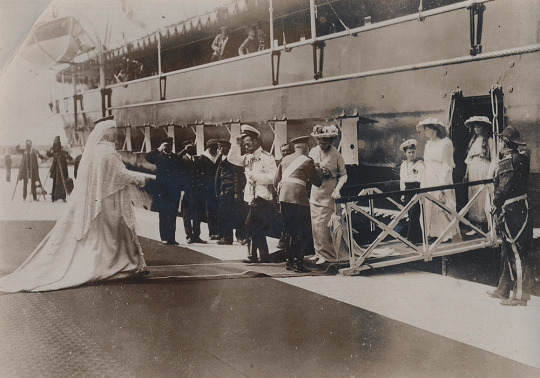
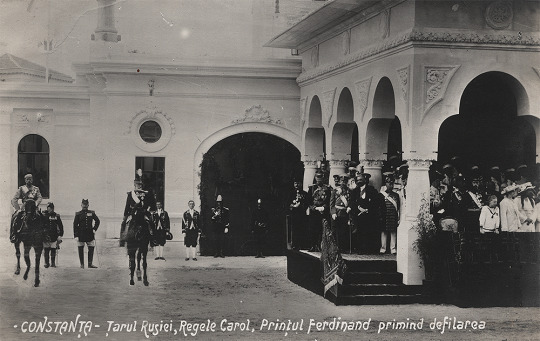
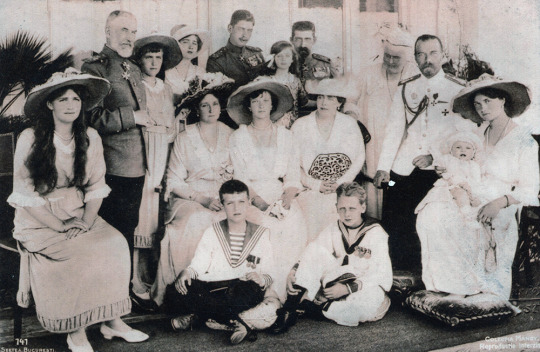
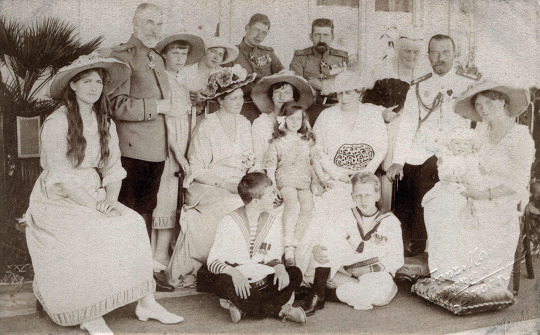
The Russian Imperial Family in Romania, 1914.
#romanov#otma#nicholas ii#alexandra feodorovna#olga nikolaevna#tatiana nikolaevna#maria nikolaevna#anastasia nikolaevna#alexei nikolaevich#carol i of romania#ferdinand of romania#carol ii of romania#mignon of romania#elisabeth of wied#nicholas of romania#nicolae of romania#maria of romania#marie of edinburgh#ileana of romania#mircea of romania#my collection#my series
97 notes
·
View notes
Text

VERY cute and rare photo of Empress Alexandra Feodorovna (née Alix of Hesse) with her newborn daughter, Anastasia Nikolaevna and her 3rd daughter Maria Nikolaevna, Peterhof 1901 🤍✨
#the definition of cute 🥹#anastasia nikolaevna#maria nikolaevna#otma#naotmaa#otmaa#romanov#alexandra feodorovna#alix of hesse#peterhof#1901#romanovs
160 notes
·
View notes
Text

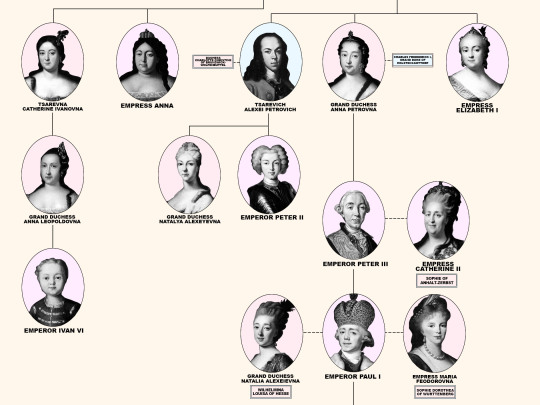
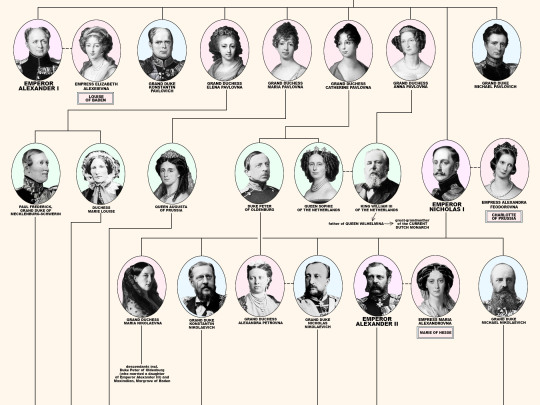
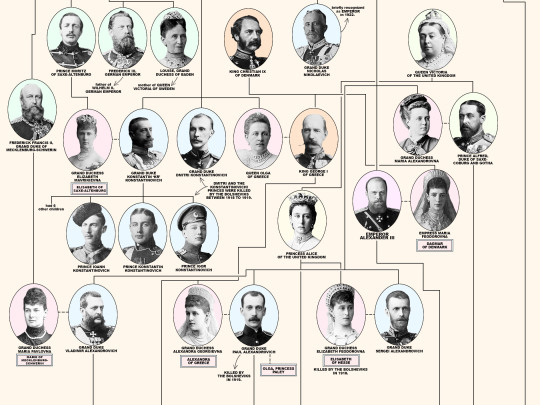

Members of the House of Romanov, the last reigning Dynasty of Russia.
From the first Romanov Russian Tsar Michael I (reigned 1613-1645) until the last Emperor Nicholas II (reigned 1894-1917). Including the 18 members of the house executed from 1918 until 1919; Grand Duke Michael Alexandrovich (13 June 1918). Nicholas II, Empress Alexandra Feodorovna, Grand Duchesses Olga Nikolaevna, Tatiana Nikolaevna, Maria Nikolaevna, Anastasia Nikolaevna, and Tsarevich Alexei Nikolaevich (17 July 1918). Grand Duchess Elizabeth Feodorovna, Grand Duke Sergei Mikhailovich, Prince Ioann Konstantinovich, Prince Konstantin Konstantinovich, Prince Igor Konstantinovich, and Prince Vladimir Paley (18 July 1918). Grand Duke Paul Alexandrovich, Grand Duke Dmitri Konstantinovich, Grand Duke Nicholas Mikhailovich, and Grand Duke George Mikhailovich (28 January 1919).
#romanovs#history#nicholas ii#alexandra feodorovna#olga nikolaevna#tatiana nikolaevna#maria nikolaevna#anastasia nikolaevna#alexei nikolaevich#myedits#peter i#peter ii#Peter iii#peter iii#Catherine the great#tsar alexei i#tsar michael#tsar paul i#alexander i#alexander ii#alexander iii#nicholas i#ancestry
272 notes
·
View notes
Text
Vera Ignatievna Gedroits - the openly lesbian, first woman professor of surgery in Russia, who worked alongside the Romanovs

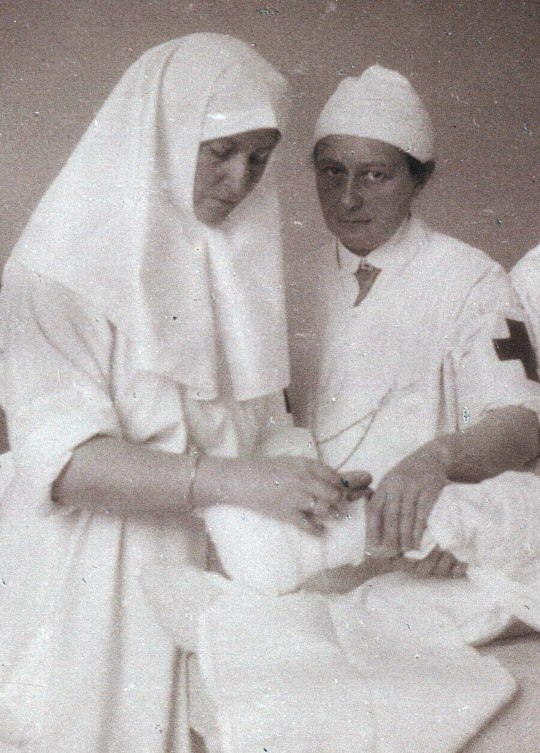
Princess Vera Ignatievna Gedroits was a doctor, surgeon, poet, and pioneer of medicine. Vera worked alongside Tsarina Alexandra and Grand Duchesses Olga and Tatiana Nikolaevna, working with the Red Cross to treat injured soldiers during the First World War.
** content warning for mention of suicide **
Born as a Princess of royal Lithuanian descent in 1870 in Kyiv, Vera is thought to have developed an interest in medicine following the passing of her little brother Sergei during childhood. Vera later wrote under the pen name ‘Sergei Gedroits’ in honour of him.
In 1892, Vera was arrested for participating in the Populist movement. Freed and undeterred, Vera was adamant to continue her medical studies. An open lesbian, Vera entered into a marriage of convenience with friend Nikolai Belozerov, permitting the obtaining of a new passport to travel, allowing her to pursue her dream of a medical career without the restriction of borders and her previous name being on police records. Despite their marriage being one of convenience, rather that romantic love, Vera and Nikolai were close friends, and stayed in contact through letters.
In 1903, Vera obtained the title of ‘female doctor’, but later that year attempted suicide. Vera’s mental health had declined due to an overwhelming personal family life, the death of her sister, exhausting workload, and breakup of a relationship with a lady in Switzerland. The following year, Vera had recovered, and the outbreak of the Russo-Japanese war led to her working in horse-drawn mobile hospitals.
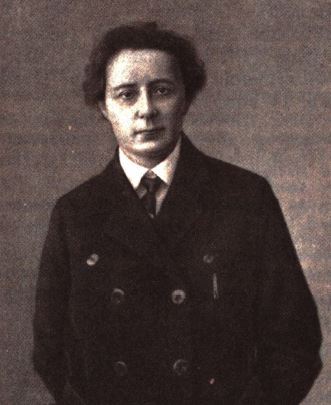
Working with wounded patients, Vera took detailed notes which allowed the making of the connection between injuries and the weapon used to inflict them. Interestingly, Vera did not shy away from abdominal operations, which was irregular due to previous thoughts that such injuries were ‘inoperable’. Often, patients with such injuries were refused surgery and were sadly left to pass away.
Following the War, Vera worked provincially, attending to 125,363 patients. This pioneering work was recognised by Tsarina Alexandra Feodorovna in 1909, who invited Vera to take the position of Senior Court Physician. Vera was the first woman to serve as a physician in the Imperial Palace. Vera wrote ‘Conversations on Surgery for Sisters and Doctors’ to help the Palace understand the profession. Vera would eventually write 58 scientific papers. Vera earned a Doctorate of Surgery on May 11 1912, the first woman in the history of the University of Moscow to do so.
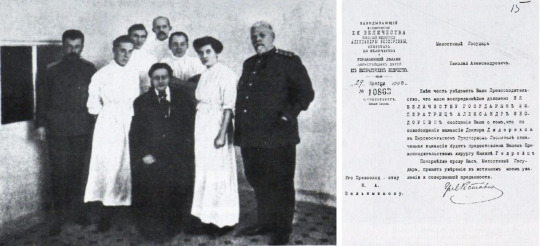
Following the outbreak of the First World War, Vera helped to install physiotherapy equipment and X-ray machines in hospitals to aid recovery. Vera taught Tsarina Alexandra Feodorovna and her daughters, Grand Duchesses Olga and Tatiana, medical work, and they assisted with operations. Vera worked alongside Imperial Physician Dr. Evgeny Botkin to help connect infirmaries to railways and supplies. Vera occasionally travelled to the front lines to help provide surgery directly at the scene, and in one case performed over 30 operations over a three day period.
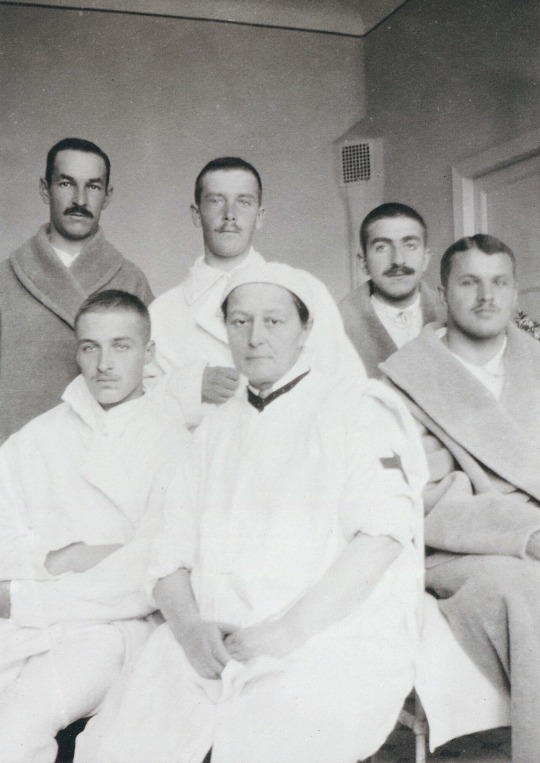
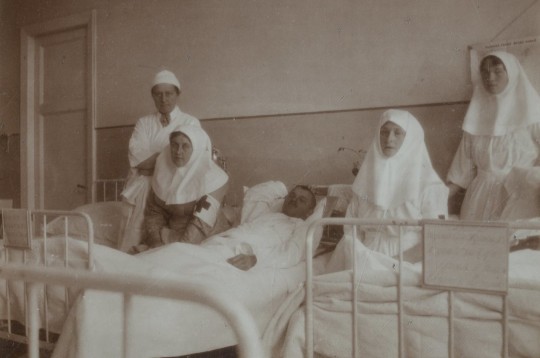
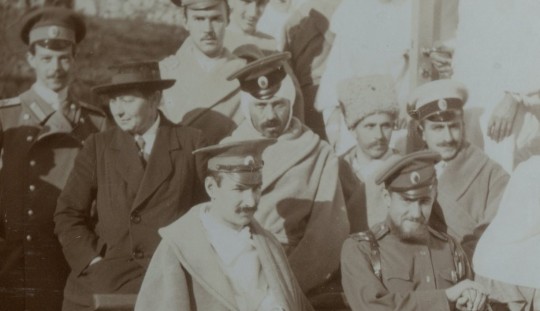
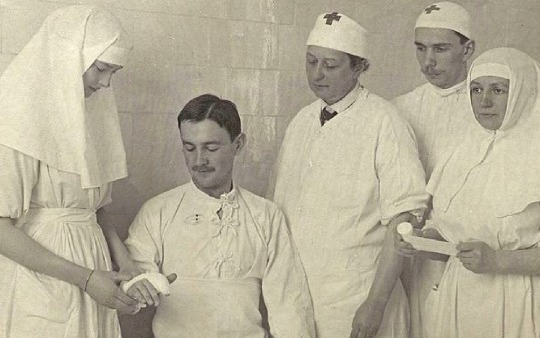
Vera is recorded as having little patience for the infamous Grigori Rasputin, with one source recording the shoving of Rasputin ‘into a corridor when he refused to get out’ of the way.
There are no records that suggest that the patients or the Romanovs objected to Vera's sexuality, though there was disapproval of her continuing to remain in Tsarskoe Selo to continue military surgery after the Revolution. If anything, she was renowned as one of the most capable and intelligent women of the era. Vera wore a surgeon's cap rather than the head coverings that nurses and Sisters of Mercy wore.
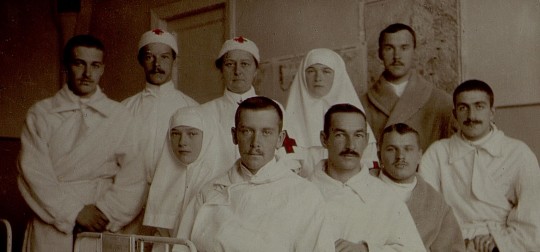


During the First World War, Vera met fellow nurse Countess Maria Dmitrievna Nirod-Mukhanova, a widowed maid-of-honour at the palace. The pair fell in love and started a relationship, which would last for the rest of Vera’s life. Maria had three children: Dmitri Feodorovich, Marina Feodorovna, and Feodor Feodorovich. The children knew about their mother's relationship with Vera, as they lived as a married couple whilst caring for and raising them. Some sources suggest that Vera and Maria had a marriage ceremony.

By the late 1920s, Vera was living with Maria, who worked as a surgeon, in Kyiv after the couple and Maria’s children escaped Revolution, taking refuge with monks. They spent eighteen years together. The pair lived as a married couple. In 1932, Vera passed away aged 61 after a diagnosis of uterine cancer. Maria continued Vera’s work by operating a pharmacy that provided free medicine to the poor. Maria passed away in 1965 aged 86. The above image is the only photo that has been attributed to her.
Vera defied all the social norms, becoming a pioneer of medicine and challenging traditions within the profession, saving thousands of lives in the process. Vera’s legacy lives on today.
SOURCES:
Hands that bring back to life. Vera Ignatievna Gedroits - surgeon and poet by V.G. Khokhlov
Beinecke Rare Book and Manuscript Library
Wartime albums of Olga Nikolaevna and Tatiana Nikolaevna, Last Romanovs on Flickr
The Princess who Transformed War Medicine - BBC
Princess Vera Gedroits: military surgeon, poet, and author by J.D.C. Bennet
The Diary of Olga Romanov : Royal Witness to the Russian Revolution by Helen Azar
Tatiana Romanov, Daughter of the Last Tsar : Diaries and Letters, 1913-1918 by Helen Azar and Nicholas B.A. Nicholson
#Vera Gedroitz#Vera Gedroits#lgbt history#lesbian history#Alexandra Feodorovna#Olga Nikolaevna#Tatiana Nikolaevna#Maria Nirod Mukhanova#medical history#Russian history#pride month#tw sui#image described#queer history
239 notes
·
View notes
Text


Period dramas dresses tournament: Grey/Silver dresses Semifinals- Groups A & B: Isolde, Tristan & Isolde (gifset) vs The tsarina, Anastasia the musical (pics set)
#period drama dresses tournament#tournament poll#tumblr tournament#polls#fashion poll#isolde#tristan & isolde#tristan and isolde#the tsarina#alexandra feodorovna#anastasia the musical#anastasia#gs semifinals
54 notes
·
View notes
Text

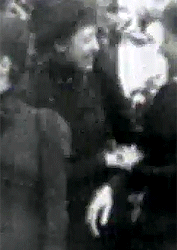

First cousins Princess Victoria of the United Kingdom (1868-1935) and Empress Alexandra Feodorovna (1872-1918) having a laugh together at a family photo session at Bernstorff Palace in Denmark in 1899 ✨
#toria and alix 😭🫶#holding hands 🤌#royaltyedit#historyedit#alexandra feodorovna#princess victoria#british royal family#princess victoria of the united kingdom#imperial russia#1899#royal cousins#**#gif: misc#fredensborgdagene
223 notes
·
View notes
Text
Alexandra Feodorovna’s Wedding Dress

“Her wedding dress was a magnificent creation; the outfit was so intricate that it took nearly an hour for Alexandra to dress. Her stockings were of lace, her shoes embroidered and decorated. Over these she wore layers of stiff petticoats. The wide, full skirt of silver brocade opened from the waist down to reveal a second underskirt of silver tissue, edged with fur. The décolletage was cut low, to reveal the neck and shoulders, and the gown had short sleeves trailing ermine-edged tippets. The tightly fitted, boned bodice was sewn with diamonds which sparkled with every move. The folds of the overskirt fell back to form a train, and a separate, sweeping court train of cloth-of-gold edged with ermine fell from her shoulders. Over this, Alexandra wore the imperial mantle of cloth-of-gold, lined and edged with ermine. These robes were so heavy that four pages had to help carry them.
Alexandra wore her hair swept back to emphasise her graceful neck and shoulders. Two long, twin side curls were attached to her own hair. Her long veil of tulle was held in place by a Russian Kokoshnik tiara, of diamonds set in platinum, and the Romanov nuptial crown of diamonds sewn on crimson velvet. Alexandra also wore a number of diamond brooches on the front of her gown, along with the jewelled chain of the Order of St. Andrew and strings of pearls around her neck. These jewels, as well as the tiara, had been wedding gifts from the late tsar, costing some 300,000 rubles ($150,000). She also wore the imperial riviére, a diamond necklace of 475 carats, and a pair of matching earrings. The earrings were so heavy, in fact, that they had to be supported by wires around the ears, which slowly cut into the flesh as the day wore on. Around her tiara, Alexandra wore a wreath of orange blossoms, brought from the Imperial Conservatory in Warsaw. Across the dress stretched the red ribbon of the Order of St. Catherine.”
[Greg King, The Last Empress: The Life and Times of Alexandra Feodorovna, Tsarina of Russia]
144 notes
·
View notes
Text

A rare photo of Tsarevich Alexei, Tsarina Alexandra Feodorovna and Grand Duchess Olga Nikolaevna in Peterhof, summer of 1913.
#ooh new rare!#romanov#romanovs#olga nikolaevna#alexandra feodorovna#alexei nikolaevich#peterhof#1910s#1913#summer#summer 1913#summer in peterhof#russian imperial family homes#old royals#old royal photos#vintage photography
88 notes
·
View notes
Text
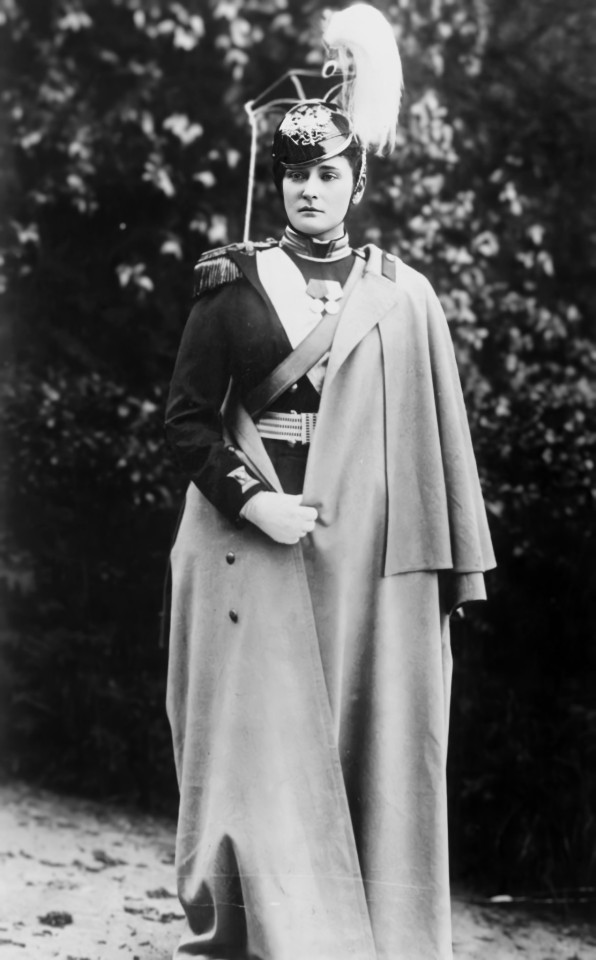



Portraits of Empress Alexandra Feodorovna wearing uniform of the chief of the 5th Hussar Alexandria regiment, Tsarkoye Selo, 1911.
#alix of hesse#alix of hesse and by rhine#alexandra feodorovna#louis iv#princess alice#princess alice of the united kingdom#queen victoria#victoria#prince albert#albert#victorian#victorian era#germany#hesse#rhine#russia#princess#empress#tsarina#czarina#tsaritsa#royal#royalty#history#portrait#photo
133 notes
·
View notes
Text
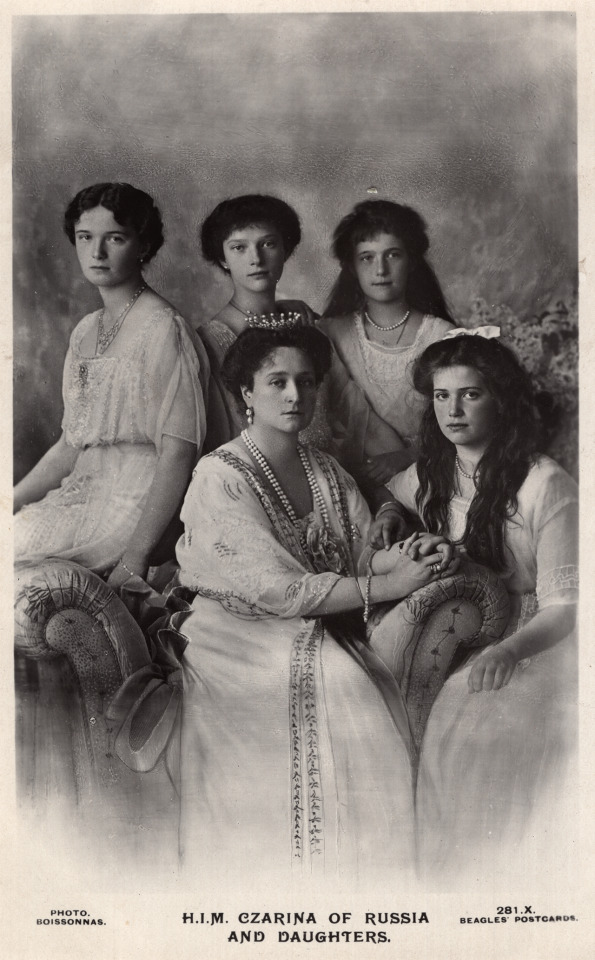
Alexandra Feodorovna with her daughters, 1913.
Another example of "old timey Photoshop." All the other postcard versions of this image are landscape; for some reason this one was published in portrait orientation. That meant they had to draw in the rest of Alix and Maria's skirts as well as the chair. They didn't . . . they didn't do great. The draping on Alix's especially looks very stiff and unnatural, being so straight. You can also see editing above Olga, Tatiana and Anastasia's heads where they had to fill in background that wasn't there.
#romanov#otma#alexandra feodorovna#olga nikolaevna#tatiana nikolaevna#maria nikolaevna#anastasia nikolaevna#formal#1913#my collection#old timey photoshop
111 notes
·
View notes
Text
The heights of the Romanov Family



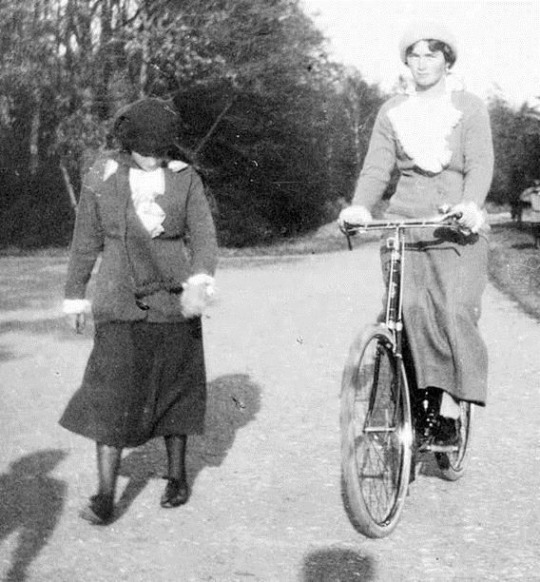


Height (in order of tallest to shortest)
Tatiana- 175cm (5ft 8/5ft9)
Maria 172cm (5ft 7/5ft8)
Tsar Nicholas II 170cm (5ft6)
Alexandra 170cm (5ft6)
Alexei 168cm (5ft6)
Olga 165cm (5ft 4 /5ft5)
Anastasia 157cm (5ft 1 /5ft2)
#russian history#tsarist russia#tatiana nikolaevna#maria nikolaevna#olga nikolaevna#anastasia romanov#alexei nikolaevich#alexandra feodorovna#romanov#otma#height check
36 notes
·
View notes
Text
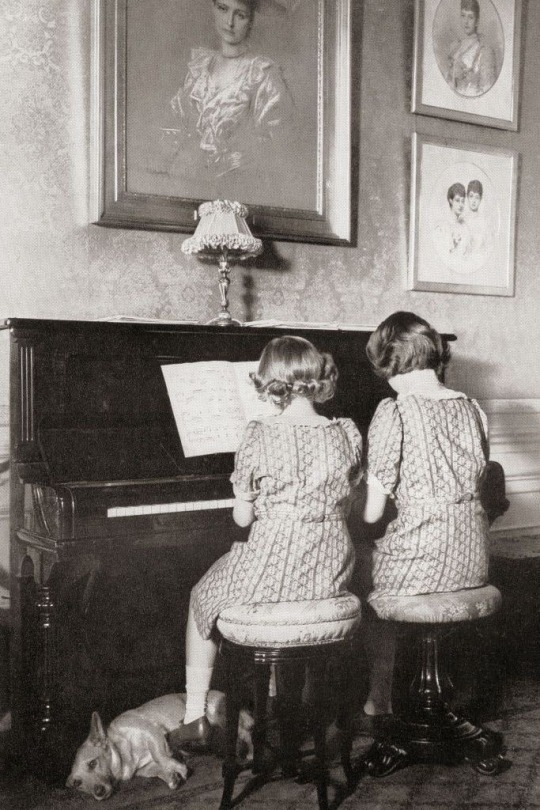
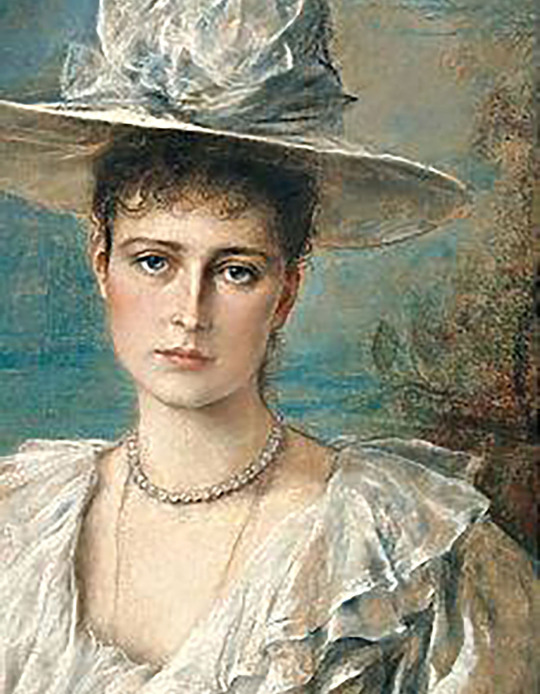
Princess Elizabeth (later Queen Elizabeth II) and Princess Margaret of the United Kingdom playing a duet on a piano at Windsor Castle, early 1940s.
Above the two princesses hangs a lesser detailed portrait of Princess Alix of Hesse and by Rhine, better known as the tragic Empress Alexandra Feodorovna of Russia, by Kaulbach (1890s).
130 notes
·
View notes
Text
Shortly before the Romanov Tercentenary celebrations in February 1913, Grand Duchess Tatiana Nikolaevna contracted typhoid, and spent much of February and March recovering.


On 21st February 1913 [O.S.] Tatiana wrote after an event in St. Petersburg that she had “a headache the entire time”. By the 24th, she had been confined to bed, and had to be carried by soldiers when the family returned to Tsarskoe Selo. From there, she was quarantined with Alexandra Tegleva, her nursemaid. Tatiana’s big sister, Olga Nikolaevna, wrote daily in her diary about Tatiana’s health, including her temperature, symptoms, and time they spent together.

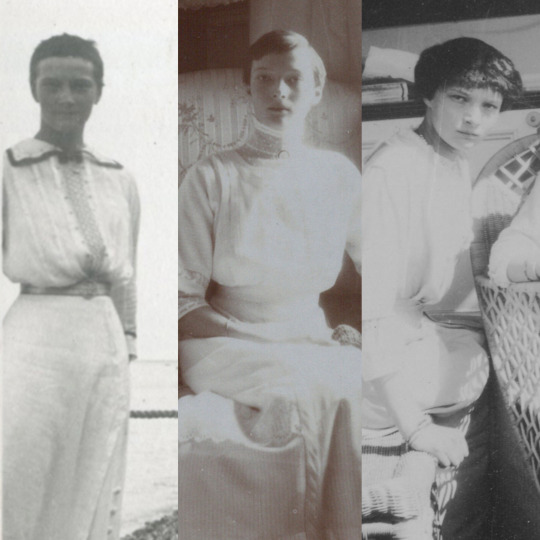
A common treatment after illness was to shave the head, as hair tended to fall out following a serious illness. On 5 March [O.S], Olga wrote in her diary that she sat with Tatiana, “who had her hair cut short.“

Tatiana wore a wig until December 1913, when Alexandra wrote to her brother and sister-in-law that “Tatiana’s hair has grown nice and thick, which means she no longer needs to wear a wig.” Some have claimed that Tatiana was embarrassed about her cropped hair, but the Grand Duchesses’ photograph albums illustrate a different view, that she was comfortable removing her wig around family, friends, and officers, as shown in these photos (see the first photograph of Tatiana taking off her wig on the Standart whilst on holiday in 1913).
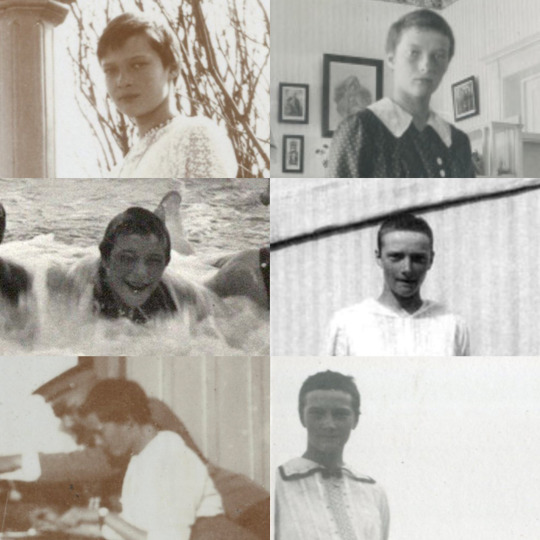

On 26 March 1913 [O.S.], Tatiana wrote in her diary “Could not write because got sick with Typhoid and they [doctors] forbade me to write.” By April, she had fully recovered in time for the Tercentenary.


Sources:
Journal of a Russian Grand Duchess: Complete Annotated 1913 Diary of Olga Romanov - H. Azar
Tatiana Romanov, Daughter of the Last Tsar: Diaries and Letters, 1913–1918 - H. Azar, N. B. A. Nicholson
The Correspondence Of The Empress Alexandra Of Russia With Ernst Ludwig And Eleonore - P. H. Kleinpenning
#Tatiana Nikolaevna#Tatiana Romanov#Olga Nikolaevna#Olga Romanov#Alexandra Feodorovna#Romanov sisters#women's history#Royal history#hair history#my own#1913#Romanov Tercentenary#diaries#letters#sources
64 notes
·
View notes
Text

Crude drawing of Empress Alexandra Feodorovna by Vladimir Pavlovich Paley (son of Tsar Nicholas II’s uncle Grand Duke Paul Alexandrovich), 1916
“The Man [Rasputin] Was Killed”
“Cheer Up Darling! Russia Isn’t Safe Yet!”
#this is kind of sad#but it shows how even members of the family disliked Alix…#drawing#Vladimir Pavlovich Paley#Vladimir Paley#alexandra feodorovna#tsarina alexandra#tsarina Alexandra feodorovna#empress alexandra feodorovna#russian history#Rasputin#grigori rasputin#russian imperial family#romanovs#romanov#1916
49 notes
·
View notes